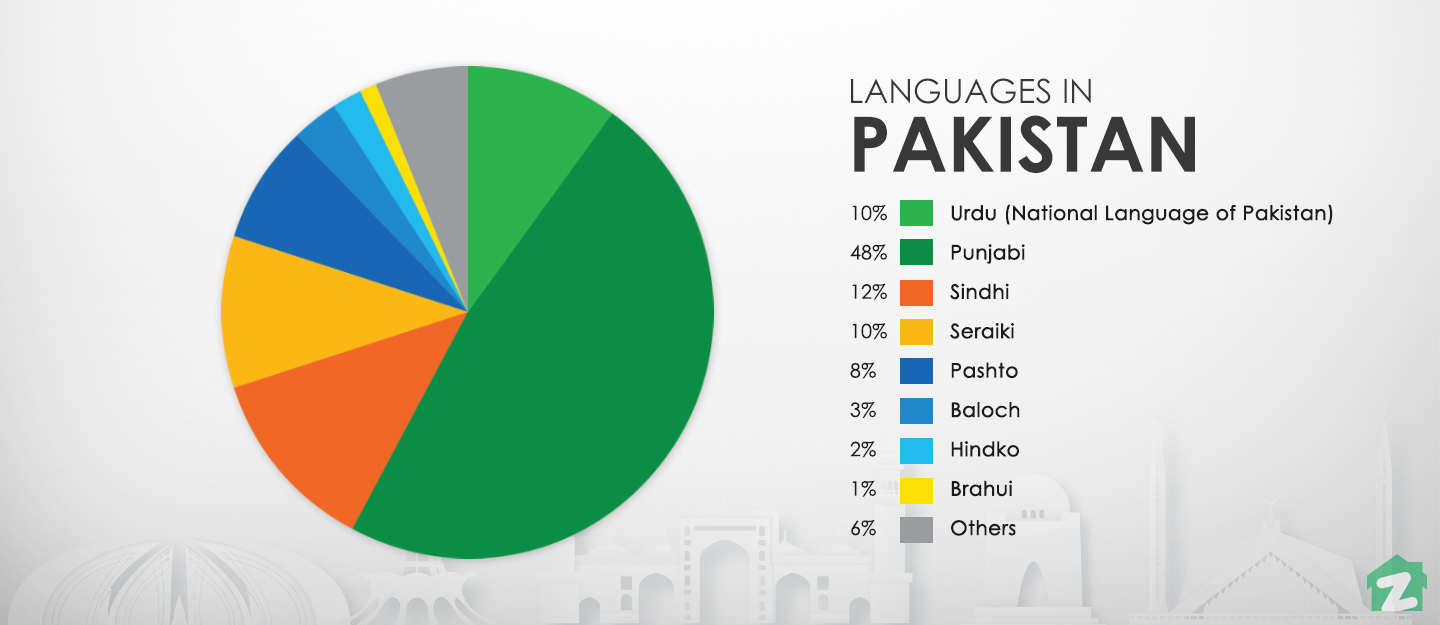English is the official language and is used in all government, educational, and business entities, and is also understood and spoken at varying levels of competence by many people around Pakistan, especially by the upper classes and people who have gone through higher levels of education.
Here is the percentage of languages currently being spoken in Pakistan
|
  |
Mapping the Languages


People Also Asked
Question 1.
How many people speak Punjabi in Pakistan, and where is it spoken?
Punjabi: Widely Spoken Across the Heartland
Punjabi holds the title of the most widely spoken regional language in Pakistan. Nearly half—about 48%—of the population speaks Punjabi as their mother tongue, with the majority found in the province of Punjab. The language is prevalent not just in rural areas but also throughout bustling urban centers like Lahore, Faisalabad, and Rawalpindi. Written in the Shahmukhi script, which shares its alphabet with Urdu, Punjabi connects millions of people across central Pakistan and serves as a vital part of the national identity.
Question 2.
Where is Pashto spoken in Pakistan, and what is its significance?
Pashto: Where It’s Spoken and Why It Matters
Pashto holds a vital place in Pakistan’s linguistic landscape. It is predominantly spoken in Khyber Pakhtunkhwa, the northern districts of Balochistan, and the areas that were formerly known as the Federally Administered Tribal Areas (FATA). You’ll also hear Pashto in the urban centers—especially in cities with sizable Pashtun migrant communities.
Beyond geography, Pashto is culturally significant. The language boasts a rich literary heritage, with legendary poets such as Khushal Khan Khattak, Rahman Baba, Khatir Afridi, and Ghani Khan weaving epic poetry and stories in Pashto. The language not only connects millions of people across regions but also serves as the heartbeat of Pashtun cultural identity, music, and oral traditions.
Question 3.
What efforts has the government made to promote Urdu in Pakistan?
Efforts by the Government of Pakistan to Promote Urdu
To strengthen national identity and cohesion, the Government of Pakistan has taken several steps to promote Urdu across the country. These efforts include introducing Urdu as a compulsory subject in schools and colleges, ensuring that governmental communication and official documents are available in Urdu, and encouraging its use in the media and legal proceedings.
Additionally, national television and radio broadcasts frequently feature Urdu programming, helping to reach a wide audience and foster a shared sense of culture. Official ceremonies, speeches, and public messaging also predominantly use Urdu, further cementing its place at the heart of Pakistani society. Through these initiatives, the government aims to encourage both proficiency and pride in the national language among citizens, regardless of their regional backgrounds.
Question 4.
What are the possible linguistic origins of Sindhi?
The Roots of Sindhi
Sindhi, predominantly spoken in the Sindh province, carries a rich history shaped by diverse linguistic influences. While some linguists trace its roots to ancient Sanskrit, others highlight significant contributions from Arabic. There are also theories suggesting links to the Sami languages, pointing to the region’s vibrant blend of cultures and tongues over the centuries. This dynamic heritage makes Sindhi an especially fascinating example of how language evolves, adapts, and absorbs from its surroundings.
Question 5.
What script is used to write Punjabi in Pakistan?
Writing System for Punjabi
In Pakistan, Punjabi is written using the Shahmukhi script, which is a variant of the Urdu alphabet. This script is used throughout the Punjab region and is distinct from the Gurmukhi script used in neighboring India. If you travel through Punjab or look at local publications, you’ll notice most Punjabi literature, newspapers, and signage employ Shahmukhi, making it the standard script for Punjabi speakers in Pakistan.
Question 6.
What is the historical origin of Urdu?
The Historical Roots of Urdu
Urdu traces its roots back to the Indian subcontinent, where it gradually emerged as a result of centuries of cultural blending. The language developed in and around Delhi, evolving as local Indo-Aryan dialects mixed with vocabulary from Persian, Arabic, and Turkic languages. This linguistic fusion took place over many generations, influenced by the arrival and rule of various empires, especially the Mughals, whose court language was Persian. As a result, Urdu grew into a rich and expressive means of communication, absorbing words, phrases, and even poetic styles from multiple traditions. Today, while only a small percentage of the population speaks Urdu as a mother tongue, it remains an important symbol of unity across the diverse regions of Pakistan.
Question 7.
What was the significance of Persian in Pakistan during the Mughal Empire, and what is its status today?
Persian: From Courtly Prestige to a Lingering Legacy
Persian once held a place of great prestige in the region, especially under the Mughal Empire, where it served as the primary language of the royal court, administration, and high culture. This gave it considerable influence among the educated and elite Muslim classes of the time. With British colonial rule, however, Persian lost its official status and was gradually replaced by English.
Today, Persian is spoken by only a small minority in Pakistan. Its lasting impact, however, can still be seen in the country’s literature, poetry, and even in the vocabulary of Urdu, which borrowed much from Persian during centuries of cultural exchange.
Question 8.
What is the role of Arabic in Pakistan’s religious education?
The Role of Arabic in Religious Education
As the predominantly Muslim nation that it is, Pakistan places significant emphasis on Arabic within its religious education systems. Arabic serves as the essential medium for studying core Islamic texts, including the Quran, Hadith, and Sunnah. While lessons often incorporate Urdu translations to aid understanding, countless students—whether in formal madrassas or informal community settings—are introduced to the basics of Arabic so they can engage with these scriptures directly. This early exposure ensures that Arabic remains central to both the formal and informal religious learning journey for a vast number of Pakistanis.
Question 9.
Which notable poets have contributed to Pashto literature?
Notable Poets of Pashto Literature
Pashto boasts a vibrant literary heritage, thanks to the contributions of several celebrated poets. Among the most prominent are Khushal Khan Khattak, often referred to as the “father of Pashto literature,” along with Rahman Baba, whose poetry is admired for its mystical depth. Others include Khatir Afridi and Ghani Khan, both of whom have played significant roles in enriching Pashto poetry and preserving its cultural identity.
Question 10.
What are the provincial languages of Pakistan?
Full Answer Combined with Your Original
Urdu is the national language and is spoken throughout Pakistan. In addition to Urdu, most Pakistanis speak their regional languages such as Punjabi, Sindhi, Pashto, Balochi, Saraiki, Shina, Burushaski, Khowar, Wakhi, Hindko, etc.
Regional Languages Across Pakistan
- Punjabi is the most widely spoken regional language, with nearly half of the population (over 44%) using it as their first language. It is written in the Shahmukhi script, a variant of the Urdu alphabet, and is especially common in the Punjab province.
- Pashto is spoken by around 15% of Pakistanis, particularly in Khyber Pakhtunkhwa, northern Balochistan, and the tribal areas. Pashto is known for its poetic tradition and is also the official language of neighboring Afghanistan.
- Sindhi finds its roots in the Sindh province, where it’s the primary language for about 14.5% of the population. With influences from Sanskrit and Arabic, Sindhi is also spoken in parts of India.
- Balochi is the principal language of Balochistan and is spoken by roughly 4% of Pakistanis. It features a rich oral tradition and serves as a cultural marker for the Baloch people.
- Saraiki, Shina, Burushaski, Khowar, Wakhi, and Hindko are among the other regional languages, reflecting Pakistan’s incredible linguistic diversity. Each language is deeply connected to its respective region and community, adding to the rich cultural tapestry of the country.
Question 11.
How is Urdu used in Pakistan?
Full Answer Combined with Your Original
Urdu is the national language and is spoken throughout Pakistan. While it holds the status of national language, only a small percentage of people—about 8%—speak Urdu as their first language. For most, Urdu is a second language, but it plays a vital role in daily communication and unifying people from various linguistic backgrounds across the country.
Urdu’s roots stretch back several centuries, evolving from an Indo-Aryan language in the Delhi region and absorbing influences from Arabic, Persian, and Chagatai over time. Today, it’s used in formal settings, government administration, and is taught in schools nationwide. The government actively promotes Urdu to help foster national solidarity and cultural connection among Pakistanis.
Question 12.
How widely is Urdu spoken as a first language in Pakistan?
Full Answer Combined with Your Original
Urdu 07.60% Although only 7.60% of Pakistanis speak Urdu as their first language, it holds a unique status as both the official and national language of the country. Urdu serves as a linguistic bridge, uniting speakers of Pakistan’s numerous regional languages, and is used widely in government, education, and media.
Question 13.
What is the prevalence of Sindhi in Pakistan, and where is it primarily spoken?
Full Answer Combined with Your Original
Here is the percentage of languages currently being spoken in Pakistan
Percentage: Punjabi 48.17% Pashto 13.14% Sindhi 11.77% Saraiki 09.83% Urdu 07.60% Balochi 03.02% Hindko 02.43% Barahvi 01.21% Others 02.81% Among these, Sindhi is spoken as a first language primarily by people residing in the Sindh province. Nearly 14.5% of Pakistanis—an impressive portion of the population—use Sindhi as their mother tongue, making it an essential part of the nation’s linguistic identity.
Question 14.
How widely is Balochi spoken and where is it used in Pakistan?
Full Answer Combined with Your Original
Balochi 03.02% Spoken predominantly in the province of Balochistan, Balochi is another of Pakistan’s provincial languages. Roughly 3-4% of the population communicates in Balochi, making it an integral part of the cultural fabric in the country’s southwest.
Question 15.
What are the minority languages of Pakistan, and what is their status?
Full Answer Combined with Your Original
Urdu is the national language and is spoken throughout Pakistan. In addition to Urdu, most Pakistanis speak their regional languages, such as Punjabi, Sindhi, Pashto, Balochi, Saraiki, Shina, Burushaski, Khowar, Wakhi, Hindko, etc.
English is the official language and is used in all government, educational, and business entities, and is also understood and spoken at varying levels of competence by many people around Pakistan, especially by the upper classes and people who have gone through higher levels of education.
Beyond these major and regional tongues, Pakistan is also home to a rich tapestry of minority languages. Dozens of smaller languages are spoken by minority communities scattered across the country. The number of speakers for these languages can range from a few hundred to just a few thousand. Some of these languages—including Burushaski, Wakhi, and Khowar—are considered endangered, and may face extinction in the coming decades if current trends continue. This linguistic diversity highlights both the cultural wealth and the vulnerability of Pakistan’s lesser-known communities.
Here is the percentage of languages currently being spoken in Pakistan
Percentage: Punjabi 48.17% Pashto 13.14% Sindhi 11.77% Saraiki 09.83% Urdu 07.60% Balochi 03.02% Hindko 02.43% Barahvi 01.21% Others 02.81%
Question 16.
Which foreign languages have a significant impact in Pakistan?
Full Answer Combined with Your Original
English is the official language and is used in all government, educational, and business entities, and is also understood and spoken at varying levels of competence by many people around Pakistan, especially by the upper classes and people who have gone through higher levels of education.
Beyond English, a few other foreign languages have played significant roles in Pakistan’s linguistic landscape:
Arabic
As the religious language of Muslims, Arabic holds great importance in Pakistan, especially in religious education. The Quran, Hadith, and other Islamic texts are studied in Arabic, and most Pakistanis receive at least some instruction in the language through mosques, religious schools, or formal education.
Persian
Historically, Persian was the language of the Mughal Empire and held a prestigious place in society and administration for centuries. Though its use has declined since colonial times, Persian’s cultural influence remains, and it is still spoken by a small segment of the population.
These foreign languages, alongside the many regional languages, contribute to Pakistan’s rich and varied linguistic heritage.
Further Information on Local Languages
- Wikipedia: https://en.wikipedia.org/wiki/Languages_of_Pakistan
- Details on Local Languages: www.ethnologue.com/country/PK
- National Language: www.omniglot.com/writing/urdu

